Appendages
General structure
Ostracods typically have seven pairs of segmented appendages, the caudal rami (furcae or uropods of some authors), and sexual organs. The ostracod body has been reduced so that the carapace can entirely enclose the non-calcified parts of the body. Because of this, the division between the head, thorax and abdomen are obscure.The head supports four pairs of appendages, the antennules, antennae, mandibles and maxillula (or first maxilla). There is debate as to whether the fifth pair of appendages belong to the head, or are the first pair of thoracic appendages because of a lack of a clear boundary between the head and thorax.
Crustacean limbs, with the exception of the antennule and caudal ramus, are derived from a biramous limb (a limb consisting of two main branches). The base consists of a coxa and basis, which together form the protopod (also called a protopodite). Endites are protrusions on the inner edge of the protopod. The two branches, typically segmented, are called the exopod (= exopodite) and endopod (=endopodite), the exopod being the outer most one.
Antennule
The antennule (also called the antennula or first antenna) is the first appendage of an ostracod, located near the anterior end of the hinge.It is uniramous (consisting of a single branch) in all groups.
The antennule consists of between five and eight segments.
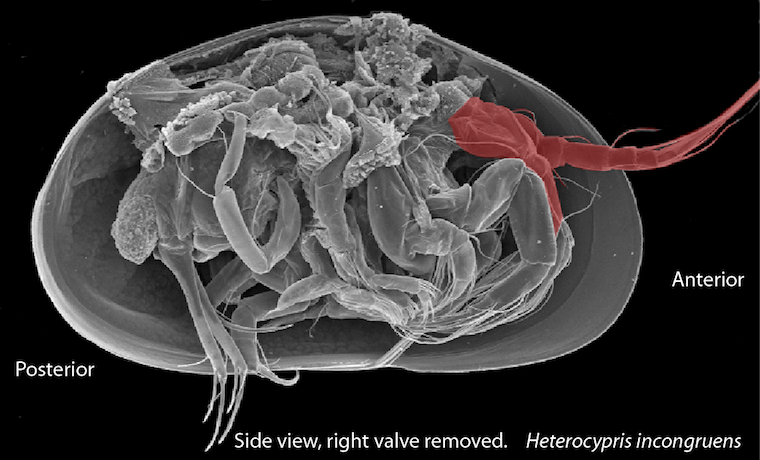
The antennules of some groups, such as some Cypridoidea, are long and slender, and are flexible enough to be used for swimming in conjunction with the antennae. When the ostracod is at rest, the long setae are fanned out to sense movements in the water.
In other groups, the antennules are much more robust, and used for moving through sediments.
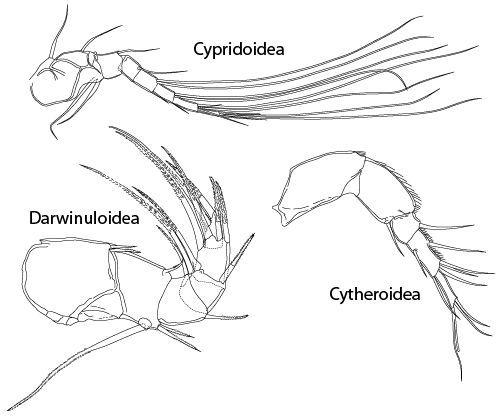
Antenna
The antennae, (singular antenna, sometimes called the second antenna) is the second pair of limbs.It originates from the head, either side of the forehead and and is biramous, meaning that it has two branches (the endopod and exopod) originating from its basis.
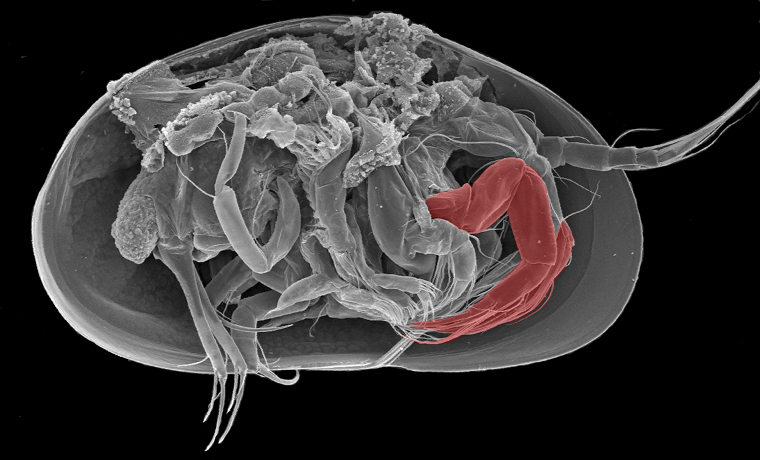
The antennae are used for crawling (in conjunction with the thoracic appendages), and in some groups for swimming (in conjunction with the antennules). It is also used to drag food to the mouth region, and in some groups it is sexually dimorphic. Males have a different arrangement of setae and claws compared with the females.
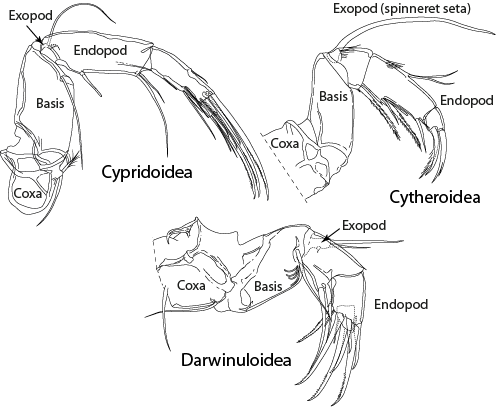
Mandible
The mandibles are located each side of the mouth region. They are used for moving food to the mouth, and to masticate the food in the oral cavity.It originates from the head, either side of the forehead and and is biramous, meaning that it has two branches (the endopod and exopod) originating from its basis.
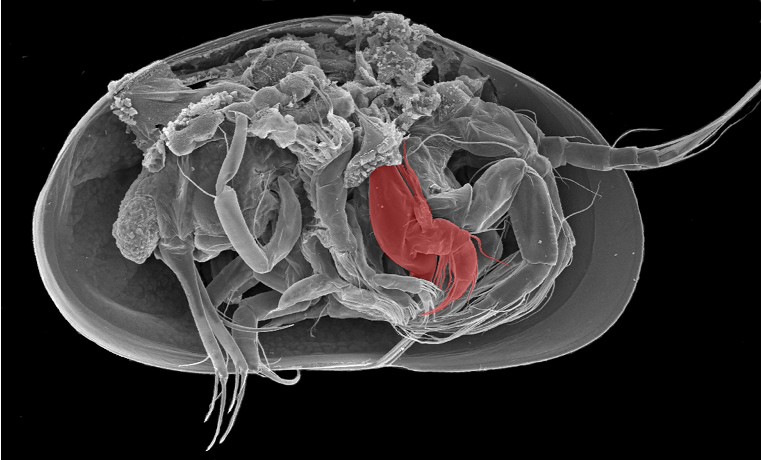
There are two main parts to the mandible, the coxa and the palp. The coxa has teeth on its inner side, and these protrude into the oral cavity to masticate the food from the side. The palp is used to sweep food towards the mouth cavity.
The first segment of the palp is the basis. The rest of the palp is the endopodite. The small branchial plate protruding from the basis is probably the exopod.
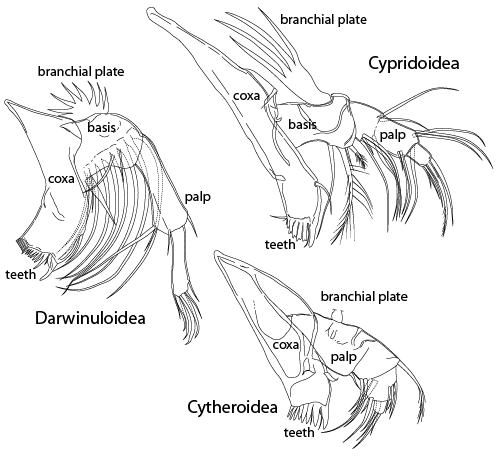
Maxillula
The fourth limb is called the maxillula. This has two main parts to it. The anterior parts point towards the mouth cavity and are used for feeding (endopod and endites). The posterior part consists of a large branchial plate, which is an exopod. The movement of the branchial plates create a current of water through the cavity of the carapace, and hence help with respiration.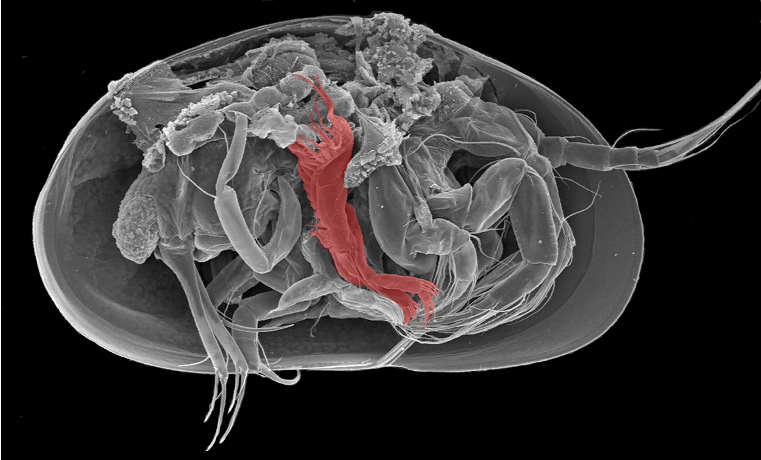
The general structure of the maxillula is very similar in most groups, although some of the anterior parts (endopod and endites) are reduced in some taxa, and very rarely the branchial plate is missing (some Entocytheridae).

Fifth Limb
The most basic form is a walking leg, similar in morphology to the sixth limb. In such cases, it is usually the smallest of the walking legs. In other groups the waking leg is reduced, and the protopodite is enlarged towards the mouth, forming an endite. This is used for feeding.
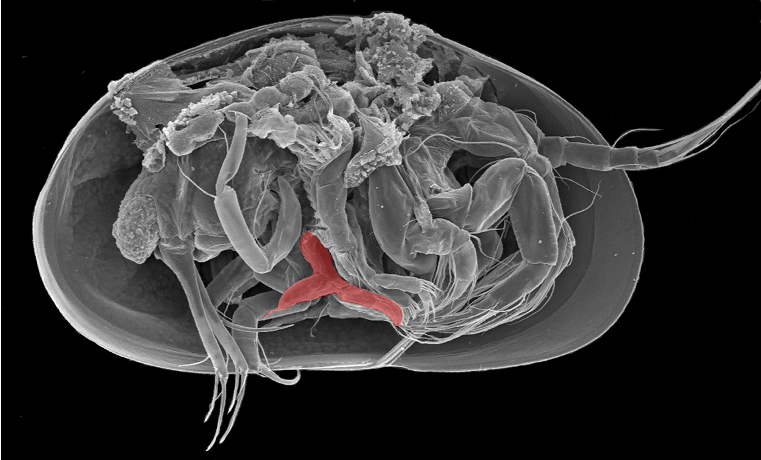
In some groups, the endopod is reduced into a non-segmented palp in the females, and a functions as a clasper in the males, used during copulation.
Typically, the fifth limb has a branchial plate (probably an exopod), similar but much smaller than the branchial plate of the fourth limb, the maxillula.
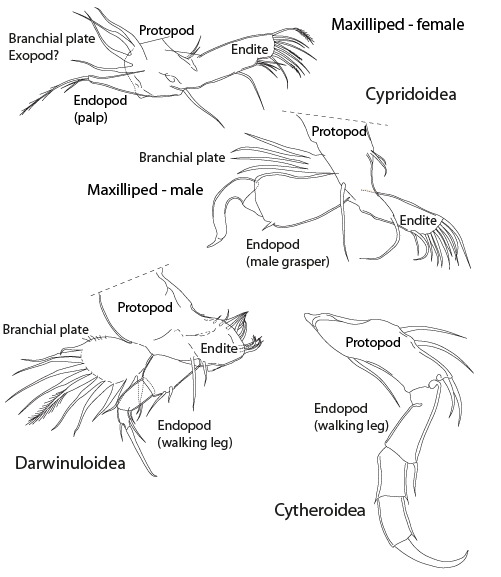
Sixth Limb
The sixth limb is situated in the posterior section of the carapace.It is a walking limb in most groups, but can be a clasping appendage (male Platycopina), reduced (female Platycopina, some Myodocopida) or absent (some Myodocopida).
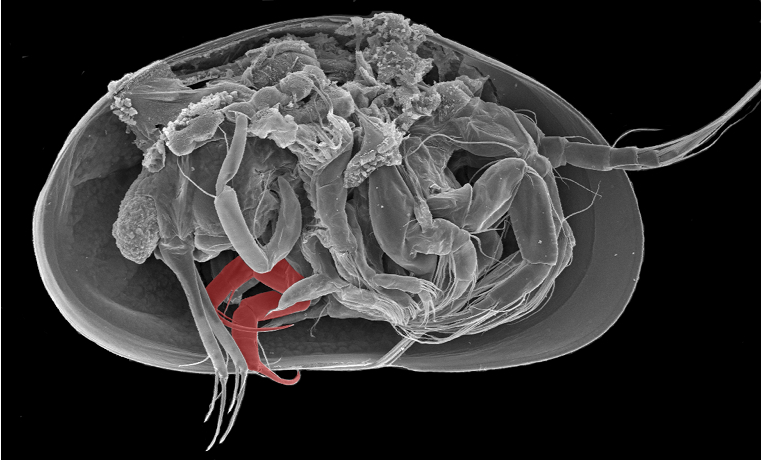
When it is a walking limb, it typically has four or five segments, and usually ends with a claw, although in some groups it can end with two claws (e.g. Superfamily Terrestricytheroidea).
The first segment of the sixth limb is the protopod, while the other segments are the endopod.
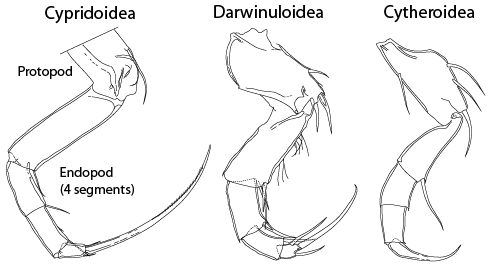
Seventh Limb
The seventh limb is located in the posterior region of the carapace. It is either a walking leg, similar in shape to the sixth limb, or a cleaning limb bent upwards into the carapace.
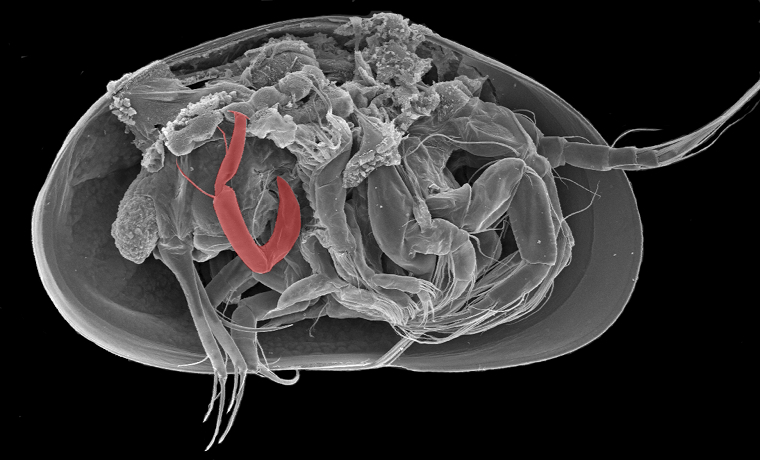
Similar to the sixth limb, the first segment of the seventh limb is the protopod, while the other segments are the endopod.
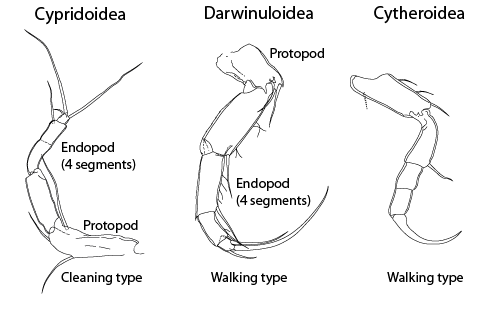
Caudal ramus
The caudal ramus (plural caudal rami) is the last appendage, found at the posterior of the body. Other names used for this appendage include furca and uropodal ramus.
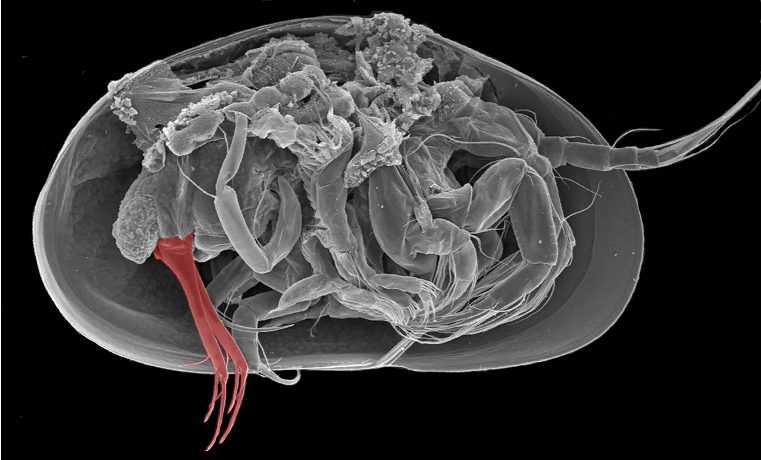
It typically has a stiff ramus or base with a number of setae and claws protruding from it. Internally, the caudal ramus is connected to the caudal ramus attachment.
The caudal ramus is used for locomotion, while in some groups it is also used to manoeuvre the male sexual organs during copulation.
In some groups, the caudal ramus can be reduced or absent altogether in the adults, but it is present in the early juvenile stages of these groups.
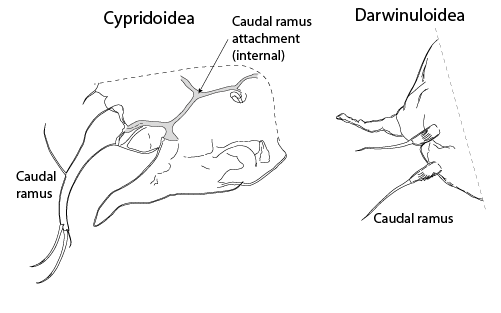
Sexual organs
The male sexual organs (hemipenes) are very useful for ostracod taxonomy because the morphology is usually different for each species.
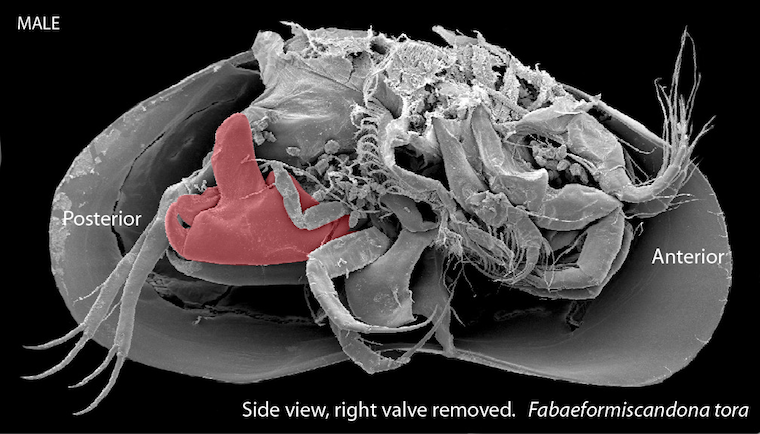
The hemipenes are complex structures that in the Cypridoidea unfold and hook onto the female's genital lobes. In that group there are no internal muscles, and the movement and unfolding is caused by hydraulic pressure created by a large muscular pump (called the Zenker organ) inside the body. In other groups there are muscles inside the male sexual organs, and these are responsible for movement and the pumping of the sperm into the females.
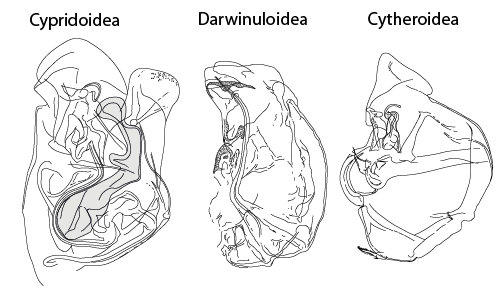
The female sexual organs usually consist of a pair of rounded lobes housing the openings of the vaginas and oviducts. Sometimes there are protrusions from the lobes, which are used by the males to hook onto during copulation.
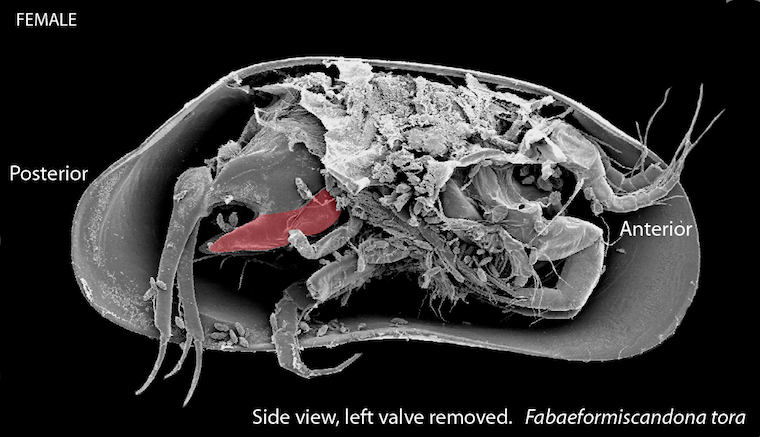
During copulation ostracods use both sets of sexual organs simultaneously.
